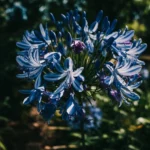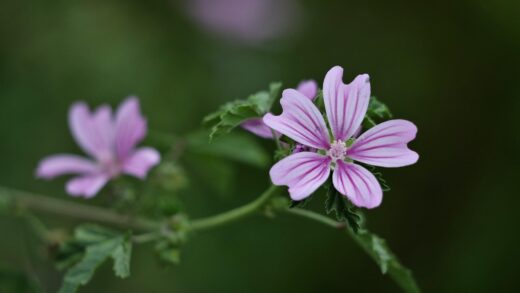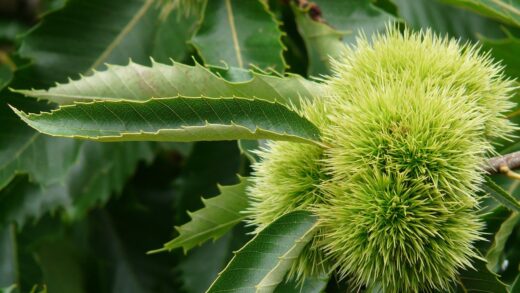While bellflowers are known for their general resilience and ease of care, they are, like all garden plants, susceptible to a range of diseases and pests that can mar their beauty and compromise their health. A vigilant gardener who can identify and address these issues early is far more likely to maintain a thriving display. Most problems can be managed or prevented entirely through good cultural practices, such as ensuring proper spacing for air circulation, watering correctly, and maintaining a clean garden environment. Understanding the most common culprits, from fungal diseases that thrive in damp conditions to sap-sucking insects that target new growth, is the first step towards effective and responsible management. This chapter provides a detailed overview of the potential health challenges bellflowers may face.
One of the most frequently encountered diseases affecting bellflowers is powdery mildew. This fungal disease is easily identified by the characteristic white, powder-like patches that appear on the leaves, stems, and sometimes the flowers. While it rarely kills the plant, a severe infection can reduce photosynthesis, cause leaf distortion and yellowing, and is aesthetically unappeasing. Powdery mildew thrives in conditions of high humidity and poor air circulation, making it particularly common during warm, damp summers. Overcrowded plantings are especially vulnerable, as the dense foliage traps moisture and prevents air from moving freely between the plants.
Another common group of pests that are particularly fond of bellflowers are slugs and snails. These mollusks are most active during damp, mild weather and can cause significant damage, especially to young plants and emerging shoots in the spring. They feed by rasping away at the plant tissue, leaving behind ragged holes in the leaves and tell-tale slime trails. A severe infestation can completely defoliate a young plant overnight. Their preference for tender growth means that the damage they inflict early in the season can stunt the plant’s development and reduce its overall vigor and flowering capacity.
Aphids are small, sap-sucking insects that can also become a problem, particularly on the soft new growth and flower buds of bellflowers. They typically congregate in dense colonies and use their piercing mouthparts to feed on the plant’s fluids. This feeding can cause the new growth to become stunted, curled, or distorted. As they feed, aphids excrete a sticky substance known as honeydew, which can coat the leaves and lead to the secondary problem of sooty mold, a black fungus that grows on the honeydew and can interfere with the plant’s ability to photosynthesize.
Rust is another fungal disease that can affect bellflowers, although it is generally less common than powdery mildew. It is characterized by the appearance of small, raised pustules on the undersides of the leaves, which are typically orange, brown, or yellow in color. These pustules contain the fungal spores that can spread to other parts of the plant and to neighboring plants, particularly in wet and humid conditions. A severe rust infection can cause the leaves to yellow and drop prematurely, weakening the plant and reducing its aesthetic appeal. Like other fungal diseases, its prevalence is closely linked to environmental conditions.
More articles on this topic
Fungal diseases in detail
A deeper look into fungal diseases reveals that prevention is the most effective strategy. For powdery mildew, the cornerstone of prevention is promoting excellent air circulation. This starts with proper spacing at the time of planting, ensuring that even at maturity, the plants will not be packed tightly together. Thinning out dense clumps of established bellflowers can also help to improve air movement through the foliage. Additionally, watering practices play a huge role; using a soaker hose or watering wand to apply water directly to the soil at the base of the plant keeps the leaves dry, making the environment much less hospitable for fungal spore germination.
When powdery mildew does appear, early intervention can prevent it from spreading. At the first sign of the white, powdery spots, affected leaves should be removed and disposed of, but not in the compost pile where the spores could persist. For more widespread infections, there are several fungicidal treatments available. Horticultural oils and neem oil can be effective, as can sprays containing potassium bicarbonate, which works by changing the pH of the leaf surface, making it difficult for the fungus to survive. These treatments work best when applied preventatively or at the very early stages of an infection and may require repeat applications.
Rust diseases, caused by various species of fungi, also thrive in moist environments. The preventative measures are therefore very similar to those for powdery mildew: ensure good air circulation, avoid overhead watering, and water in the morning so that any moisture on the leaves has a chance to evaporate during the day. Good garden sanitation is particularly important in controlling rust. In the autumn, it is crucial to clean up and destroy any fallen leaves or infected plant debris, as the rust fungus can overwinter on this material and reinfect the plants in the following spring.
If a rust infection takes hold, the management strategy is similar to that for powdery mildew. Prune off and destroy the most heavily infected leaves to reduce the number of spores available to spread. In severe or persistent cases, a fungicide specifically labeled for use against rust fungi can be applied. It is important to read and follow the label instructions carefully, paying attention to the recommended application frequency and safety precautions. For gardeners who have persistent problems with fungal diseases, it may also be worth seeking out bellflower varieties that are known to have better disease resistance.
More articles on this topic
Common invertebrate pests
Beyond slugs and snails, several other invertebrate pests can occasionally trouble bellflowers. Spider mites, for instance, are tiny arachnids that can be a problem, especially in hot, dry conditions. They are difficult to see with the naked eye, but their presence is often indicated by a fine webbing on the leaves and a stippled or speckled appearance on the leaf surface, caused by their feeding. They suck the contents out of individual plant cells, which can cause the leaves to turn yellow or bronze and eventually drop. Spider mites dislike humid conditions, so regularly misting the foliage can sometimes deter them.
If a spider mite infestation becomes established, it can be controlled with applications of insecticidal soap or horticultural oil. These products work by smothering the mites and are most effective when applied thoroughly, ensuring complete coverage of all plant surfaces, especially the undersides of the leaves where the mites tend to congregate. It may be necessary to apply the treatment several times, at five- to seven-day intervals, to control newly hatched mites. Encouraging natural predators, such as ladybugs and predatory mites, can also provide effective long-term biological control.
Vine weevils are another pest that can cause serious damage, primarily through the actions of their larvae. The adult weevils are nocturnal and feed on the leaves, creating characteristic notches around the edges. While this leaf damage is mostly cosmetic, the real problem lies with the C-shaped, cream-colored grubs that live in the soil and feed on the plant’s roots. This root damage can cause the plant to wilt and, in severe cases, can kill it entirely. Vine weevils are a particularly significant problem for container-grown plants, where the root system is confined.
Controlling vine weevil larvae can be challenging. One of the most effective methods is the use of pathogenic nematodes, which are microscopic soil-dwelling organisms that seek out and kill the larvae. These are applied as a drench to the soil in the late summer or early autumn when the soil is warm and the larvae are active. For container plants, it is also possible to drench the soil with a suitable insecticide, or to repot the plant in the spring, physically removing any grubs found in the old soil. Checking plants for signs of adult weevil notching in the summer can give an early warning of a potential grub problem later in the season.
Prevention through cultural practices
The most powerful tool in the gardener’s arsenal against pests and diseases is the implementation of sound cultural practices. A healthy, vigorous plant growing in its preferred conditions is inherently more resistant to problems than a plant that is stressed by a poor location, improper watering, or nutrient deficiencies. Therefore, the first line of defense is to start with the basics: planting the right bellflower in the right place. This means choosing a site with the appropriate amount of sunlight and, most importantly, providing the well-drained soil that is critical for root health.
Maintaining good garden hygiene is another cornerstone of preventative care. This involves promptly removing any diseased leaves or stems as soon as they are noticed to prevent the spread of pathogens. It is also crucial to clear away all dead plant debris from around the base of the bellflowers at the end of the growing season. This old foliage and stems can provide a sheltered place for fungal spores, insect eggs, and pests like slugs to overwinter, creating an immediate source of re-infestation the following spring. A clean garden bed heading into winter is a healthier garden bed in the spring.
The way a garden is watered can have a profound effect on disease pressure. As has been emphasized, overhead watering that wets the foliage creates the perfect moist environment for fungal diseases like powdery mildew and rust to flourish. By consistently using soaker hoses, drip irrigation, or simply watering carefully at the base of the plant, the foliage remains dry and disease problems are significantly reduced. It is also beneficial to water in the morning, which gives the sun and air movement the entire day to dry off any splashes that may have occurred, rather than in the evening, which leaves the foliage damp overnight.
Finally, promoting biodiversity in the garden is a highly effective long-term strategy for pest management. By planting a wide variety of plants, including those that provide nectar and pollen for beneficial insects, a gardener can attract a standing army of natural predators. Ladybugs, lacewings, hoverflies, and predatory wasps all feed on common pests like aphids, helping to keep their populations in check without the need for chemical sprays. A diverse ecosystem is a balanced ecosystem, and this natural form of pest control is both effective and sustainable.
Managing slugs and snails
Slugs and snails represent one of the most persistent and frustrating pest challenges for bellflower enthusiasts, particularly in damper climates. Their voracious appetites can lead to swift and severe damage, making effective management a high priority. A multi-pronged approach, combining several different control methods, is usually more successful than relying on a single technique. One of the simplest methods is trapping. This can be done by placing boards or flat stones in the garden; slugs and snails will congregate underneath them seeking shelter during the day, where they can then be collected and disposed of.
Beer traps are a classic and effective method for controlling these pests. A shallow container, such as a yogurt pot or tuna can, is sunk into the ground so that its rim is level with the soil surface. It is then partially filled with beer or a mixture of yeast, sugar, and water. The slugs and snails are attracted to the scent of the fermenting yeast, crawl into the container, and drown. These traps should be checked and refreshed every few days to remain effective. For the best results, place several traps throughout the garden beds where bellflowers are growing.
Creating physical barriers around the plants can also be a very effective deterrent. Slugs and snails have soft, moist bodies and are reluctant to cross sharp or abrasive surfaces. A ring of crushed eggshells, coarse sand, diatomaceous earth, or copper tape placed on the soil around the base of each bellflower plant can create a protective barrier. Diatomaceous earth, which is composed of the fossilized remains of tiny aquatic organisms, is particularly effective as its sharp microscopic edges are damaging to the pests’ bodies, causing them to dehydrate. It is important to note that these barriers must be reapplied after heavy rain.
For severe infestations where other methods have not provided sufficient control, slug pellets are an option. Traditional metaldehyde-based pellets have been a concern due to their toxicity to wildlife and pets. However, there are now much safer and more environmentally friendly alternatives available that are based on ferric phosphate. These pellets are effective at killing slugs and snails but are non-toxic to other animals. They should be scattered thinly around the plants, as per the manufacturer’s instructions, and will provide protection even in wet weather.
















